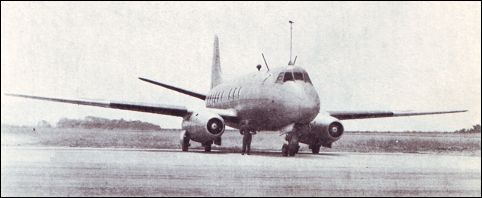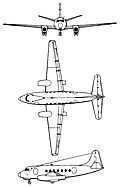 |
Vickers 663 Tay-Viscount1950 |  |
| RESEARCH AIRCRAFT | Virtual Aircraft Museum / United Kingdom / Vickers |
 |
Last of the prototype and experimental jetliners built in Britain in the immediate postwar era, the Tay-Viscount was an aircraft of great technical interest which went on to carry out many important research programmes. It came about because of Rolls-Royce's ability to wring more power from the Dart turboprop, which in turn enabled Vickers-Armstrongs (Aircraft) at Weybridge to enlarge the Viscount. This left the second of the original small-size V.630 Viscounts redundant, and the Ministry of Supply took it under its wing as a twin-jet for special research. With company designation V.663, it was kept the same size as the original first prototype but completed with new turbojet engine pods and four separate main landing gears retracting on either side of the jetpipes as on the earlier Nene-Viking. Each engine was the Rolls-Royce Tay, a slightly larger and more powerful development of the Nene which, by chance, never flew in any other aircraft (though similar engines were made under licence in the USA and France). Thanks to the advanced high-speed design of the Viscount nothing much had to be done to the airframe to clear it for high-speed jet flight, though the interior was fitted out for instrumentation instead of passengers. Originally allocated civil registration G-AHRG, the Tay-Viscount was completed in Ministry markings with serial number VX217. It first flew at Wisley on March 15, 1950, and caused a sensation at the 1950 Farnborough show by appearing to be even faster than the Comet. Its first major task was to help develop the Boulton Paul-powered control system for the Vickers-Armstrongs Type 660 bomber (later named Valiant). Based at Seighford, it then went on to become the first aircraft in the world to fly with an electrically signalled flight-control system. Still with Boulton Paul (a company later absorbed into the Dowty Group) it carried out several years of research on electrically signalled flight-control systems which are only now coming into use. Weights and performance figures for the Tay-Viscount were never published, and once it had finished its early spell of display flying and gone to Boulton Paul it was hardly ever seen in public and conducted its important missions in an atmosphere of secrecy. In general take-off, climb and manoeuvrability it exceeded all other early jetliners, despite its design being settled in 1945-46. Bill Gunston "The Illustrated Encyclopedia of Commercial Aircraft", 1980

|  COMPANY PROFILE | ||||||||||||||||||||||||||||||||||||||||||
 |

|

